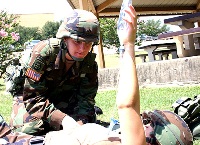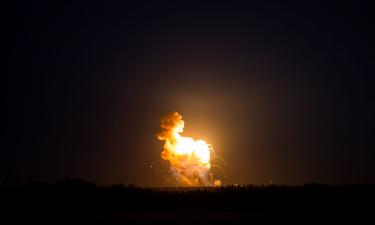American army increases medical training given to soldiers
The Army is increasing the medical training it gives to soldiers in the hope that those can begin administering critical medical care to their wounded comrades on the battlefield.

The service's five basic training bases will begin offering combat lifesaver training, including instructions on starting an IV and helping soldiers breathe through a tube, by June 15. The bases train up to 180,000 soldiers annually, including National Guard and Reserve components.
Officials said medical care given immediately after injuries like gunshot wounds and those caused by improvised explosive devices could mean the difference between life and death, and simple lifesaving techniques could cut down on longterm injuries and deaths.
"The most critical 10 minutes in a soldier's care in combat is the first 10 minutes," said Col. Kevin A. Shwedo, director of operations, plans and training for the Army Accessions Command, which oversees training. "We've focused on the skills that would give us the greatest opportunity to evacuate an individual to a higher degree of health care."
Previously, a limited number of soldiers in each unit were trained on advanced lifesaving procedures and most soldiers only received basic first aid techniques, like bandaging and performing CPR.
"You won't have to wait as long to find the one combat lifesaver you had trained," said Shwedo, whose command is based at Fort Monroe in Hampton.
More in-depth medical training can also make the difference between bringing back a patient and bringing back a corpse, said Col. Patricia R. Hastings, director of the Army's Department of Combat Medic Training based at Fort Sam Houston in Texas.
"First aid is just not good enough anymore," she said.
Soldiers at Fort Sill in Oklahoma and Fort Knox in Kentucky already have begun the training.
Col. Annie Baker, commander of 434th Field Artillery Brigade at Fort Sill, said after only 10 days at basic training, soldiers there started the combat lifesaver certification, which includes sticking needles into each other to learn how to establish an IV.
"We've had some soldiers that have been very timid and concerned because people don't like shots but not one soldier has not participated," Baker said. "Some looked a little peaked going in there, but between the medics and the drill sergeants coaching and mentoring, they've gotten through it."
Spc. John Hanson, who was a paramedic before he began training at Fort Sill, said it is important to learn the skills, even if it means getting "poked by a complete stranger or someone you've only lived with for a couple of weeks."
"We're used to getting shot at and people getting hurt," said the 29-year-old from Arlington, South Dakota "With more of us knowing how to help our buddies, maybe it will make for a more successful outcome."
The new skill training is comprised of about one week of the soldiers' nine-week training program, and follows only rifle marksmanship and physical training in the time devoted to it.
When soldiers get to the battlefield, they can use combat lifesaver bags given to each unit to help tend to fallen comrades. Those bags include supplies like IVs and saline solution, tourniquets, nerve agent antidote, and simple items like gauze and bandages.
Shwedo said the skills not only help save lives in combat, but also improve how soldiers react in situations because they know there is responsive medical care to keep them alive.
"It makes a soldier not only more confident, but more importantly, more effective," he said. "When you focus on the mission instead of 'what could happen to me' you can now take the initiative to the enemy."
Subscribe to Pravda.Ru Telegram channel, Facebook, RSS!





